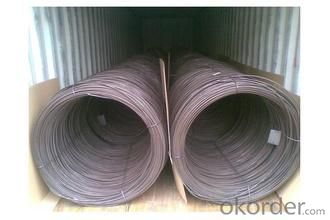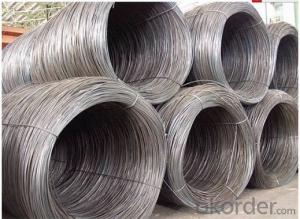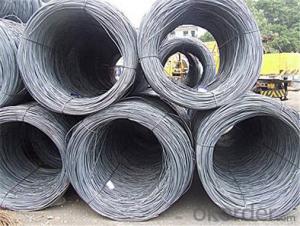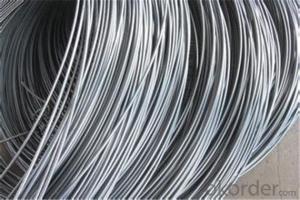SAE1006B Steel Wire Rod 6.5mm with in China
- Loading Port:
- Tianjin
- Payment Terms:
- TT OR LC
- Min Order Qty:
- 500 m.t.
- Supply Capability:
- 45555555 m.t./month
OKorder Service Pledge
OKorder Financial Service
You Might Also Like
Item specifice
Description of wire Rod:
Our company is recognized by ISO9001:2008
1. hot rolled wire rod
2. material: Q195-235
3. payment: T/T or L/C
4.size: 5mm-19mm
Festures of wire Rod:
1. Drawn wire specialist, your wire rod solution
2. ISO9001 Certified Mill &SGS
3. Feature: machinability, high hardness, toughness, corrosion resistant
4. Clear and smooth surface, high precision and Tolerance control: ± 0.01
Specifications of wire Rod:
Product | steel wire rod |
Standard | AISI, ASTM, BS, DIN, GB, JIS |
Material/steel grade | Q195-Q235,SAE1006, SAE1008, SAE1010, SAE1018, SAE1020 or according to customers requirements |
Wire Gauge | 5.5-12mm |
Coil weight | 1.8-2.1mts |
MOQ | 25MT |
Delivery Time | 15-30 days after receipt of L/C or deposit by T/T |
Packing | In coil and load in container, if large quantity, by bulk vessel; Can be packed as customers' special requirements |
Payment terms | 1).100% irrevocable L/C at sight. |
Application | widely used in machinery parts, manufacturing industry, electronics industry, metal tools and others |
Images of wire Rod:

FAQ:
1. What is your package?
Packing situation: standard seaworthy packing or as customer required.
2. How long is the lead time?
Delivery time: 45 days after order confirmed.
3. What payment term do you accept?
Payment: T/T or L/C at sight.
- Q:How is steel wire rod used in the manufacturing of wire for springs in mattresses?
- Steel wire rod is used in the manufacturing of wire for springs in mattresses as it serves as the primary material for creating the springs. The steel wire rod is first straightened and then coiled to form the spring shape. These springs provide the required support and durability to the mattress, ensuring a comfortable sleeping experience.
- Q:What are the common applications of high-strength and oil tempered steel wire rod?
- High-strength and oil tempered steel wire rod has a wide range of applications due to its unique properties. Some of the common applications include: 1. Automotive industry: High-strength steel wire rod is used in various automotive components such as suspension springs, engine valve springs, clutch springs, and seat springs. Its high tensile strength and excellent fatigue resistance make it suitable for these demanding applications. 2. Construction industry: Steel wire rod is used in construction applications such as pre-stressed concrete structures, post-tensioning systems, and reinforcement for concrete structures. Its high strength helps in providing structural stability and durability. 3. Manufacturing industry: Steel wire rod is used in the manufacturing of various products like wire ropes, cables, springs, and fasteners. Its high strength and elasticity make it ideal for these applications where flexibility and durability are required. 4. Electrical industry: Steel wire rod is used in the manufacturing of electrical conductors, such as overhead power lines and electrical cables. Its high conductivity and strength enable efficient transmission of electricity over long distances. 5. Agriculture industry: Steel wire rod is used in the manufacturing of fencing materials, barbed wires, and support structures for crops. Its strength and durability help in providing effective protection and support to agricultural fields. 6. Furniture industry: Steel wire rod is used in the manufacturing of furniture items like springs for mattresses and seating arrangements. Its ability to withstand heavy loads and provide comfort makes it a popular choice in the furniture industry. Overall, high-strength and oil tempered steel wire rod find extensive applications in various industries due to their exceptional strength, durability, and flexibility.
- Q:How is steel wire rod used in the manufacturing of wire for elevator counterweights?
- The production of wire for elevator counterweights relies heavily on steel wire rods. These rods, typically made from carbon or alloy steel, undergo a series of manufacturing processes to meet the specific requirements for elevator counterweights. To begin, the steel wire rods are thoroughly cleaned and descaled to eliminate any impurities or surface contaminants. This guarantees that the resulting wire is of the utmost quality and possesses exceptional resistance to corrosion. Subsequently, the rods are drawn through a succession of dies to reduce their diameter and increase their length. This drawing process imparts the desired tensile strength and flexibility to the wire. Following the drawing process, the wire is typically subjected to annealing, which relieves any internal stresses and enhances its ductility. This involves heating the wire to a precise temperature and gradually cooling it. Annealing not only improves the mechanical properties of the wire but also enhances its resistance to fatigue and wear. Once the wire has been drawn and annealed, it undergoes surface treatment procedures such as coating or galvanizing. Coating the wire with a protective layer, such as zinc or epoxy, serves to prevent corrosion and prolong its lifespan. Galvanizing entails immersing the wire in a bath of molten zinc to create a protective zinc coating, which offers excellent corrosion resistance. Finally, the coated or galvanized wire is further processed to achieve the desired shape and size for elevator counterweights. It can be cut into specific lengths or wound onto spools to facilitate easier handling during the manufacturing process. The wire is then utilized to construct the internal structure of elevator counterweights, which are essential for balancing the elevator car and ensuring its smooth operation. In conclusion, steel wire rods play a crucial role in the production of wire for elevator counterweights. They undergo various processes, including cleaning, drawing, annealing, and surface treatment, to produce high-quality wire with the necessary strength, flexibility, and corrosion resistance. This wire is then utilized to construct the internal structure of elevator counterweights, thus ensuring the safe and efficient operation of elevators.
- Q:What are the common forming methods for steel wire rod?
- The common forming methods for steel wire rod include drawing, rolling, and extrusion.
- Q:How is steel wire rod used in the manufacturing of fences?
- Steel wire rod is used in the manufacturing of fences as it serves as the primary raw material for producing the wires used in fencing. The wire rod is typically drawn into thin wires, which are then processed, coated, and woven into various fence designs. The strength and durability of steel wire rod ensure that the fences are sturdy and long-lasting, providing security and boundary demarcation in residential, commercial, and agricultural applications.
- Q:How is the corrosion resistance of steel wire rod evaluated?
- Various methods and tests are utilized to assess the corrosion resistance of steel wire rod. One commonly employed technique is the salt spray test, which is also known as the ASTM B117 test. During this test, the steel wire rod is exposed to a controlled environment of saltwater spray for a specific duration. Subsequently, the wire rod is inspected for any indications of corrosion, such as rust or discoloration. Another approach employed to evaluate corrosion resistance is the electrochemical test, such as the measurement of polarization curves. This test entails immersing the steel wire rod in an electrolyte solution and administering a small electric current. The resultant polarization curve provides information regarding the rate of corrosion and the propensity of the wire rod to corrode. Moreover, visual inspection and microscopic examination of the wire rod's surface can be conducted to identify any signs of corrosion, such as pitting or surface roughness. These evaluations are often supported by various corrosion measurement techniques, including analysis of weight loss, measurement of corrosion potential, and determination of corrosion rate. To summarize, the corrosion resistance of steel wire rod is evaluated through salt spray tests, electrochemical tests, visual inspection, and microscopic examination. These evaluations furnish valuable information about the wire rod's capacity to withstand corrosion and ensure its suitability for diverse applications.
- Q:How is steel wire rod used in the manufacturing of suspension cables for bridges?
- Steel wire rod is an essential component in the manufacturing of suspension cables for bridges. It is used as the primary material for constructing the main cables that support the weight of the bridge deck. The steel wire rod is highly durable and possesses excellent tensile strength, allowing it to bear the immense load and provide stability to the bridge structure. By weaving multiple strands of steel wire rod together, suspension cables are formed, which are then anchored at each end of the bridge. These cables distribute the weight of the bridge evenly, ensuring its structural integrity and enabling the safe passage of vehicles and pedestrians.
- Q:What are the common sizes of steel wire rod?
- The common sizes of steel wire rods vary depending on the specific application and industry requirements. However, some commonly used sizes of steel wire rods include diameters ranging from 5.5mm to 20mm. These sizes are typically used in the manufacturing of various products such as wire ropes, springs, nails, screws, and reinforcement bars for construction purposes. Additionally, steel wire rods can also be found in larger diameters, exceeding 20mm, for heavy-duty applications like prestressed concrete structures and suspension bridges. It's important to note that the sizes of steel wire rods can vary by region and specific industry standards, so it's always advisable to consult the relevant specifications and standards for accurate information.
- Q:How is steel wire rod used in the production of wire strands for electrical transmission lines?
- Steel wire rod is an essential component in the production of wire strands for electrical transmission lines. These wire strands are used to provide the necessary strength and conductivity for transmitting electricity over long distances. The process begins with the steel wire rod being drawn through various dies to reduce its diameter and increase its length. This drawing process helps to refine the steel and improve its mechanical properties, such as tensile strength and flexibility. Once the desired diameter is achieved, the steel wire rod is then twisted and formed into multiple individual wires, usually six or seven, which are then grouped together to form a wire strand. This twisting process helps to enhance the overall strength and durability of the wire strand. The wire strands are then coated with a protective layer, such as zinc or aluminum, through a process called galvanization. This coating not only provides corrosion resistance but also helps to improve the electrical conductivity of the wire strand. The wire strands are finally assembled into a larger conductor, along with other components such as steel or aluminum wires, to create the electrical transmission line. These transmission lines are responsible for carrying high voltage electricity from power plants to substations, where it is then distributed to homes, businesses, and other facilities. In summary, steel wire rod is a crucial raw material in the production of wire strands for electrical transmission lines. Through a series of processing steps, including drawing, twisting, and galvanization, the steel wire rod is transformed into wire strands that possess the necessary strength, conductivity, and durability required for transmitting electricity efficiently and reliably.
- Q:How does the brittleness of steel wire rod vary with different wire drawing processes?
- Different wire drawing processes can result in varying brittleness of steel wire rod. Wire drawing involves reducing the wire's diameter by pulling it through dies. The specific process used has a significant impact on the wire's final properties, including brittleness. One factor affecting brittleness is the reduction in area during wire drawing. This refers to the amount of material removed as the wire passes through the dies. Higher reductions in area lead to more deformation and strain, increasing brittleness. This occurs because the steel's grain structure becomes elongated and aligned, making it more prone to cracking and breaking under stress. Another influence on brittleness is the drawing speed. Higher speeds create greater strain and deformation, increasing brittleness. Rapid cooling during drawing can also contribute to brittleness by promoting the formation of brittle phases in the steel structure. The heat treatment applied after drawing can also impact brittleness. Processes like annealing can relieve internal stresses and improve wire ductility, reducing brittleness. Conversely, improper heat treatment or inadequate cooling can increase brittleness. To achieve desired mechanical properties, manufacturers must carefully control factors such as reduction in area, drawing speed, cooling rate, and heat treatment. By doing so, they can ensure the desired brittleness of the steel wire rod.
1. Manufacturer Overview |
|
|---|---|
| Location | |
| Year Established | |
| Annual Output Value | |
| Main Markets | |
| Company Certifications | |
2. Manufacturer Certificates |
|
|---|---|
| a) Certification Name | |
| Range | |
| Reference | |
| Validity Period | |
3. Manufacturer Capability |
|
|---|---|
| a)Trade Capacity | |
| Nearest Port | |
| Export Percentage | |
| No.of Employees in Trade Department | |
| Language Spoken: | |
| b)Factory Information | |
| Factory Size: | |
| No. of Production Lines | |
| Contract Manufacturing | |
| Product Price Range | |
Send your message to us
SAE1006B Steel Wire Rod 6.5mm with in China
- Loading Port:
- Tianjin
- Payment Terms:
- TT OR LC
- Min Order Qty:
- 500 m.t.
- Supply Capability:
- 45555555 m.t./month
OKorder Service Pledge
OKorder Financial Service
Similar products
New products
Hot products
Related keywords



























